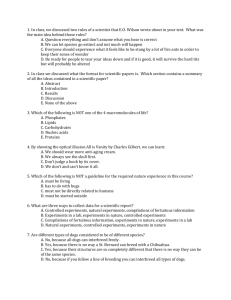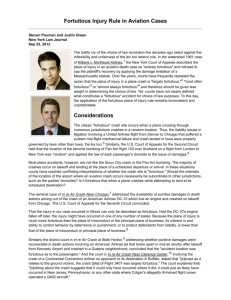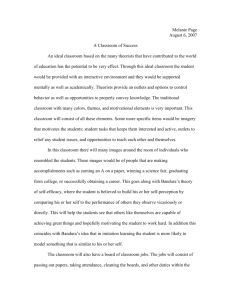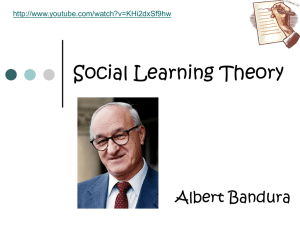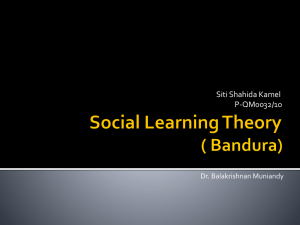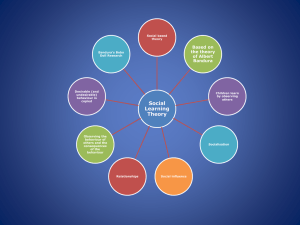Exploration of Fortuitous Determinants of Life Paths
advertisement
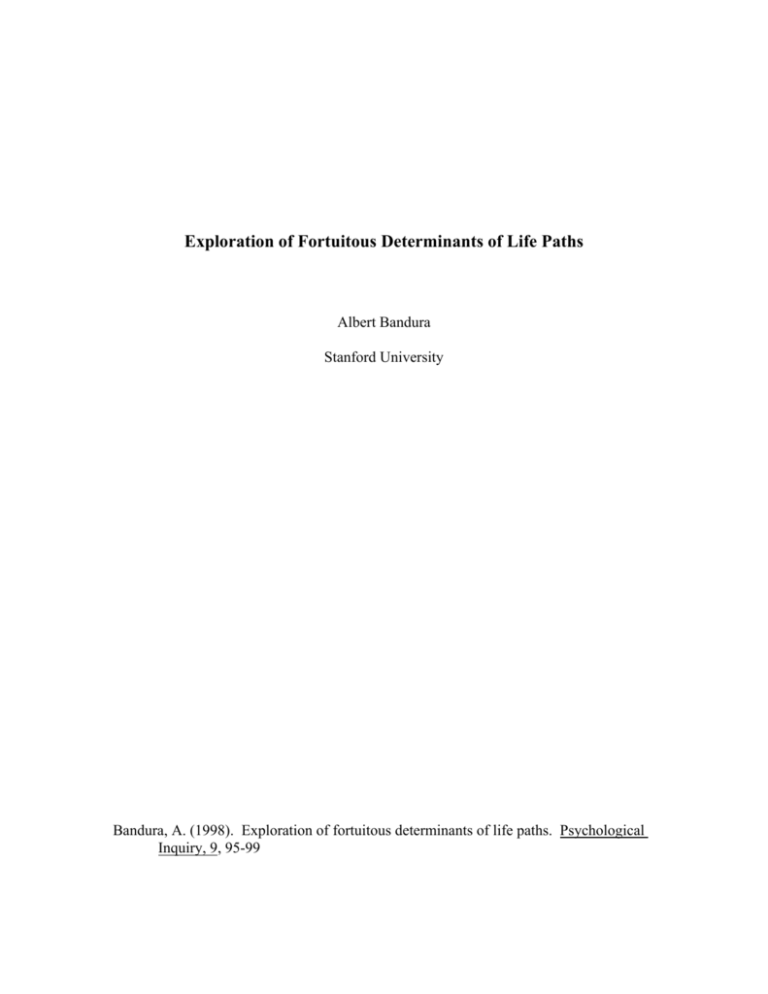
Exploration of Fortuitous Determinants of Life Paths Albert Bandura Stanford University Bandura, A. (1998). Exploration of fortuitous determinants of life paths. Psychological Inquiry, 9, 95-99 2 David Krantz is to be commended for addressing an issue that remains ever dormant in psychological theorizing even though it often plays a critical role in the paths lives take. Under certain conditions, to be analyzed later, fortuitous events set in motion constellations of influences that alter the course of lives. Krantz’s commentary centers on two major issues: The disregard of fortuitous influences in the causal structures of the social sciences; and the asymmetry in the acknowledgment of fortuitous influences in narratives of beneficial happenings and in narratives of misfortune. He attributes the disregard of fortuitous events in both scientific inquiry and narrative reconstructions of misfortunes to the aversiveness of unpredictability and uncontrollability. According to this motivational interpretation, people seek order and meaning in their lives. The acknowledgment of inability to predict and control events that can have deleterious personal consequences is highly unsettling. To gain some tranquillity in a chaotic world, people turn a deaf ear to fortuity in misfortune. In the case of the scientific enterprise, social scientists seeking universal laws with approaches modeled after physics are unsettled by events they cannot predict and control. As a consequence, they dismiss fortuitous influences as unworthy of study. The striving for meaning, predictability and control over life circumstances permeates most everything people do throughout their life course because it provides innumerable personal and social benefits (Baltes & Baltes, 1986; Bandura, 1997; Langer, 1983; Rodin, Schooler & Schaie, 1990). However, before settling on threat reduction as the sole explanation for the downplay of fortuitous determinants, I would like to propose several alternative interpretations. Moreover, I do not share Krantz’s jaundiced view of our scientific enterprise and have reservations about the prescribed theoretical remedy for the conspicuous neglect of fortuitous determinants. Fortuitous events can take impersonal forms, but the interpersonal varieties are the common ones that carry the greatest potential impact. Therefore, this commentary will focus mainly on socially-mediated happenstances. For the purposes of the present discussion, a chance event is defined as an unintended meeting of persons unfamiliar with each other. Although the separate chains of events in a chance encounter have their own causal determinants, their intersection occurs fortuitously rather than by design (Nagel, 1961). It is not that a fortuitous event is uncaused but, rather, there is a lot of randomness to its determining conditions. The profusion of separate chains of events in everyday life provides myriad opportunities for such fortuitous intersects. People are often inaugurated into marital partnerships, occupational careers and other life paths through the most trivial of circumstances (Bandura, 1982). A happenstance meeting launches a new life trajectory. Had the chance encounter not occurred, the participants lives would have taken quite different courses. 3 Evidence for the fortuitous shaping of life trajectories is almost invariably based on recollections of unintended encounters that constitute turning points in lives. Although there is little doubt about the verdicality of fortuitous events that redirect lives, as in the formation of marital partnerships and choice of careers, concerns do arise about the vagaries of recollections about events that occasion less weighty decisions. However, the branching power of fortuity is readily demonstrable prospectively as well as retrospectively. Some years ago I delivered a presidential address to the Western Psychological Association on the psychology of chance encounters and life paths (Bandura, 1982). At the convention the following year an editor of one of the publishing houses explained to me that he had entered the lecture hall as it was rapidly filling up and seized an empty chair near the entrance. In the coming week he will be marrying the woman who happened to be seated next to him. With only a momentary change in time of entry, seating constellations would have altered and this intersect would not have occurred. A marital partnership was thus fortuitously formed at a talk devoted to fortuitous determinants of life paths! Asymmetry in the Acknowledgment of Fortuity Krantz (in press) reports that fortuity is readily acknowledged in narratives of beneficial happenings, but generally goes unrecognized in narratives of misfortune. In the examples provided, lottery players embrace and court chance, whereas accident victims seldom notice happenstance as a factor in their mishaps. As previously noted, Krantz ascribes the nondiscernment of fortuity in misfortune to the threat of unpredictability and uncontrollability. The circumstances surrounding beneficial and detrimental outcomes can vary on a variety of dimensions. Comparative analyses must, therefore, include multiple controls for possible confounding effects before attributing the differences to threat value. Given the multidetermination of outcomes, events may differ in the amount and type of control individuals exercise over positive and negative outcomes. For example, a lottery is not only an impersonal event but depends entirely on sheer randomness of determining conditions. Apart from purchasing tickets, lottery players exert no control whatsoever over the constellation of events that determine the outcome. In the case of an automobile mishap it is an interpersonal occurrence in which a driver can try to exercise some control at the time of the event to reduce its severity. Thus, fortuity is essentially the sole player in the impersonal lottery but only a bit player in an interpersonal auto accident. Unless positive and negative fortuities are equated on the social factor and the degree of control the events permit, comparisons of chance attributions will yield confounded data. The relative salience of co-occurring determinants also affects how much attention fortuitous factors command. Interactive narrative reconstructions can arouse social evaluative concerns that affect the readiness of acknowledge fortuitous factors in accounts of good and bad fortune. Exuberant reports by lottery winners that they were blessed by chance would be well received, whereas losers complaining bitterly that they were victims of chance might be regarded as hitting the sauce too hard or off their medication. Methodological safeguards must be included to ensure that the data reflect differential discernment of 4 fortuitous factors across positive and negative occurrences rather than selective reportage. Krantz’s conceptual paper would benefit from an explicit definition of what constitutes a chance event. In structuring the topic, Krantz provides a classic example of a fortuitous event shaping life courses. A flight delayed by an unexpected storm creates a fortuitous intersect by two people seated next to each other at the airport that eventuates in a marriage, geographic relocation and a shift in career trajectory, none of which would have occurred if the original flight had departed on time. However, in investigating people’s discernment of fortuity, Krantz uses the impersonal occurrence of a lottery outcome, which may not be generalizable to socially-mediated events that go awry. Fortuity can take different forms. In social cognitive theory (Bandura, 1986), prior unfamiliarity of the participants and nonintentionality of the intersections are key defining criteria. The delay-spawned wedlock clearly fits this standard. In the case of the lottery, the outcome is dominated by a random conjunction of elements over which the individual has no control, but in other ways it violates the defining properties of a chance occurrence. Players deliberately purchase lottery tickets to secure the desired prize. Some even buy large numbers of tickets to increase their changes of winning. If deliberate pursuit of a desired outcome with only a small personal contribution to the multicausality is considered a fortuitous happening, is it really distinguishable from any other intentional activity permitting minimal personal control? A theory of fortuity requires specification of the types of chance occurrences the inquiry is designed to clarify. People’s discernment of fortuitous influences must be distinguished from their actual role in causal structures. People may underplay the contribution of fortuity to their misfortune, but others readily recognize it. Some of these involve fortuitous detrimental happenings in which the sufferer simply happened to be in the wrong place at the wrong time. They may get injured, maimed or deeply enmeshed in nightmarish events that leave lasting debilitating effects. In tragic cases, as when a innocent person is unexpectedly caught in a cross-fire and killed by a drive-by shooting, the unfortunate victim is no longer around to provide narratives. In many fortuitous misfortunes, individuals are launched on a disastrous trajectory by an initially benign chance encounter that leads down a calamitous path. I present elsewhere an analysis of this type of chain of events (Bandura, 1973). Conceptual Receptivity to Fortuitous Events Krantz indicts the enamorment of social scientists with the physics model and laboratory experimentation for the conspicuous neglect of fortuitous determinants. After slaying the obstinate laboratory dragon, Krantz concludes resignedly that efforts to clarify the processes through which fortuitous events affect people’s lives are a beguiling way of avoiding issues that may be “fundamentally unresolvable on a data level.” He argues that psychology should forsake prediction and control for the humanistic methodology of description and explanation. Given that prediction is one of the best ways of testing a given explanation, how is the adequacy of explanations to be verified in 5 the descriptive methodology? Considering that prediction and control lie at the very heart of Krantz’s explanation of people’s reactions to chance occurrences, it is ironic to see these very processes summarily jettisoned as matters worth of study. The picture regarding the role of fortuitous events in causal structures is not as bleak as Krantz portrays it. Fortuity is entering the agenda of scientific discourse (Austin, 1978; Bandura, 1982, 1986; Merbaum & Lowe, 1982; Miller, 1983; Munn, 1983; Stagner, 1981). Theorists who approach human development from a life-span perspective treat the environment, not as a situational entity, but as a varied succession of life events that differ in their power to affect the direction lives take. They have added fortuitous events to biological events and normative social events as important classes of determinants that shape life courses (Baltes, 1983). Given an informative conceptual scheme, progress in a field is heavily dependent on methodological advances that open up an area for study by providing the necessary investigatory tools. In many areas of psychology, what we lack is not theories but good measures of the determinants and processes they posit. Researchers are understandably disinclined to go fishing in murky waters without a fishing rod. Research on fortuity presents special challenges because fortuitous intersects are not only unforeseeable but, when they do occur, they operate through intricate networks of influences over time requiring multifaceted prospective studies. Even in the case of intentionally structured influences, our analytic methodologies for identifying unfolding life trajectories is still rather primitive. Providing new insights into the contributory role of fortuitous events in human life courses requires integrating knowledge from diverse methodologies. Laboratory studies are needed to specify the mechanisms through which the types of influences that operate in a chance encounter exert their effects. Controlled field studies are needed to advance understanding of how to equip people with personal resources that enable them to make the most of positive fortuitous opportunities and ward off negative fortuities (Bandura, 1997). Short-run naturalistic studies are needed to elucidate how the branching processes operate after fortuitous intersects inaugurate individuals into new social systems with different models, incentive structures, social sanctions and value preferences. And finally, we need a reliable methodology for assessing the characteristics of life events and analytic tools for tracing lifepaths. This would include ways of identifying branch points and the constellation of conditions operating at the time. A multifaceted research strategy offers the greatest promise for advancing our understanding of how fortuitous events contribute to life trajectories. Foretelling Fortuitous Happenings Versus Predicting and Altering Their Impact. Many chance encounters have little if any impact on people’s lives; others may produce some adaptational variation without altering the basic direction of the life course; and still others branch people into new trajectories of life. One must distinguish between the predictability of fortuitous events and the effects they exert once they occur. The science of psychology cannot foretell the occurrence of fortuitous intersects, except in a very general way. Personal proclivities, the social circles in which one moves and 6 the kinds of people who populate those settings make some types of intersects more probable than others. Thus, for example, a child living in a crime-ridden subcommunity is likely to experience quite different chance encounters than one living in a residential prep school. However, psychology can provide a conceptual scheme for predicting the nature, scope, and strength of the impact that chance encounters will have on human lives. The fact that an initiating event is fortuitous does not mean that the entire trajectory is a random one. Framing a fortuitously-activated processes of change as ones that are empirically unanalyzable is a prescription for investigatory paralysis. A previous article presented a preliminary conceptual scheme encompassing both personal and environmental factors for predicting the effects that fortuitous events are likely to have (Bandura, 1982). The personal determinants of the impact of chance encounters operate by converting a chance meeting into an ongoing relationship. People’s attributes, interests and skills will affect whether they can gain sufficient social acceptance to sustain involvement with those they happened to encounter. Emotional ties also play an influential role. Interpersonal attraction seals chance encounters into lasting bonds. Values and personal standards similarly come into play. Chance meetings are more likely to last if the persons involved have similar value commitments and standards than if they clash. The social determinants of the impact of chance encounters center on the holding and shaping power of the milieus into which people are fortuitously inaugurated. People become attached to groups that provide valued benefits and rewards but forsake those that have little to offer. Fortuitous induction into a group also provides a new symbolic environment designed to foster affinity, solidarity, and shape ideological perspectives on life. The belief system of milieus and their reach and degree of closedness operate as other formative environmental factors. Chance encounters have the greatest potential for abruptly branching people into new trajectories of life when they induct them into a relatively closed milieu. A totalistic environment supplies a pervading new reality—new kinships, strongly held group beliefs and values, all-encompassing codes of conduct, and substantial rewarding and coercive power to alter the entire course of personal lives. In this interactional model of fortuitous effects, life trajectories are the products the dynamic interplay of personal and environmental influences. Utilizing Beneficial Fortuities and Defusing Detrimental Ones Chance events do not just happen autonomously. In social intersects the individuals are going about their business on separate activity tracks. People can make chance happen by pursuing an active life that increases the number of fortuitous encounters they are likely to experience. Indeed, Austin (1978) highlights the role of action in chance occurrences. In the proactive sociocognitive view, chance favors the inquisitive, venturesome and persistent. By selecting advantageous activities and milieus people can make chance occurrences work for them. Although People have minimal influence over the occurrence of fortuitous events, they can exercise significant control over their impact. 7 Social scientists may underplay fortuitous determinants in their etiological theorizing, but such factors figure significantly in their prescriptions for personal development (Bandura, 1995, 1997; Hamburg, 1992; Marten, Best, & Garmezy, 1990; Rutter, 1990). On the utilization side, the proactive efforts center on cultivating personal attributes that enable people to make the most of opportunities that arise unexpectedly from time to time. Pasteur put it well when he noted that “Chance favors only the prepared mind.” On the diffusing side, people are equipped with self-protective capabilities that enable them to resist social traps leading down detrimental paths, and to extricate themselves from such predicaments should they become enmeshed in them. At the societal level, people create social systems designed to cultivate efficacious selfbeliefs and generative competencies, and provide opportunity structures and supporting resources to increase the chances that people can realize what they wish to become. To reduce arbitrary and oppressive control, societies institute safeguards that set limits on the form and degree of control people can exercise over each other. By creating favorable chance opportunities, these types of measures give people a greater hand in shaping their own destinies. Knowledge of the personal and social factors that mediate the impact of chance encounters on life paths provides guides on how to foster and safeguard valued futures. Viewed from this perspective, chance is not an unpredictable and uncontrollable event that must be “tamed” because it only breeds dread. Rather, it is a fortuitous happening that can be used to one’s benefit or detriment depending on its nature and the interplay of personal and social forces it activates, which are amenable to some measure of control. 8 References Austin, J. H. (1978). Chase, chance, and creativity: The lucky art of novelty. New York: Columbia University Press. Baltes, P. B. (1983). Life-span developmental psychology: Observations on history and theory revisited. In R. M. Lerner (Ed.), Developmental psychology: Historical and philosophical perspectives (pp. 79-111). Hillsdale, N. J.: Lawrence Erlbaum. Baltes, M. M., & Baltes, P. B. (1986). The psychology of control and aging. Hillsdale, N.J.: Erlbaum. Bandura, A. (1973). Aggression: A social learning analysis. Englewood Cliff, N.J.: Prentice-Hall. Bandura, A. (1982). The psychology of chance encounters and life paths. American Psychologist, 37, 747-755. Bandura, A. (1986). Social foundations of thought and action: A social cognitive theory. Englewood Cliffs, N.J.: Prentice-Hall. Bandura, A. (1995). Self-efficacy in changing societies. New York: Cambridge University Press. Bandura, A. (1997). Self-efficacy: The exercise of control. New York: Freeman. Hamburg, D. A. (1992). Today’s children: Creating a future for a generation in crisis. New York: Times Books. Krantz, D. L. (in press). Taming chance: Social science and everyday narratives. Psychological Inquiry. Langer, E. J. (1983). The psychology of control. Beverly Hills, Calif.: Sage. Masten, A. S., Best, K. M., & Garmezy, N. (1990). Resilience and development: Contributions from the study of children who overcome adversity. Development and Psychopathology, 2, 425-444. Merbaum, M., & Lowe, M. R. (1982). Serendipity in research in clinical psychology. In P. C. Kendall & J. N. Butcher (Eds.), Handbook of research methods in clinical psychology (pp. 95-123). New York: Wiley. Miller, W. B. (1983). Chance, choice, and the future of reproduction. American Psychologist, 38, 1198-1205. Munn, N. L. (1983). More on chance encounters and life paths. American Psychologist, 38, 351-352. Nagel, E. (1961). The structure of science. New York: Harcourt, Brace and World. Rodin, J., Schooler, C., & Schaie, K. W. (Eds.), (1990). Self-directedness: Cause and effects throughout the life course. Hillsdale, N.J.: Erlbaum. Rutter, M. (1990). Psychosocial resilience and protective mechanisms. In J. Rolf, A. S. Masten, D. Cicchetti, K. H. Neuchterlein, & S. Weintraub (Eds.), Risk and protective factors in the development of psychopathology (pp. 181-214). New York: Cambridge University Press. Stagner, R. (1981). Training and experiences of some distinguished industrial psychologists. American Psychologist, 36, 497-505. 9 Author Note Preparation of this article was supported by grants from the Grant Foundation and the Spencer Foundation. Correspondence concerning this article should be addressed to Albert Bandura, Department of Psychology, Stanford University, Stanford, CA 94305-2130.
